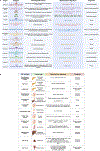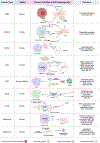Plasticity and Functional Heterogeneity of Cancer-Associated Fibroblasts
- PMID: 40729489
- PMCID: PMC12371731
- DOI: 10.1158/0008-5472.CAN-24-3037
Plasticity and Functional Heterogeneity of Cancer-Associated Fibroblasts
Abstract
Tumor heterogeneity and plasticity enable adaptation to metastatic microenvironments and resistance to therapies. Recent progress in single-cell analyses has permitted detailed characterization of the complexity and diversity of the different tumor components in multiple tumor types. Cancer-associated fibroblasts (CAF) are a central component of the tumor microenvironment and play critical roles in cancer progression and therapeutic response. The identification of different CAF subtypes and elucidation of their functional plasticity are crucial for identifying novel therapeutic approaches to target protumorigenic CAFs and harness tumor-suppressive CAFs to enhance the efficacy of cancer treatments. In this review, we discuss how intrinsic and extrinsic factors and the extensive cross-talk between cancer cells and the tumor microenvironment promote CAF heterogeneity and their contributions to cancer progression and therapeutic resistance. Understanding the roles of CAF plasticity and their intercellular interactions may drive the development of effective treatment strategies to improve patient prognosis.
©2025 American Association for Cancer Research.
Conflict of interest statement
Figures



References
-
- Dagogo-Jack I, Shaw AT. Tumour heterogeneity and resistance to cancer therapies. Nat Rev Clin Oncol. 2018;15(2):81–94. - PubMed
Publication types
MeSH terms
Grants and funding
- T32 GM144302/GM/NIGMS NIH HHS/United States
- HT9425-23-MRP-MASA-ME230214/U.S. Department of Defense (DOD)
- GM144302/National Institute of General Medical Sciences (NIGMS)
- W. W. Smith Charitable Trust (W. W. Smith Foundation)
- Melanoma Institute of Excellence (MRIE) at the Sidney Kimmel Comprehensive Cancer Center
LinkOut - more resources
Full Text Sources
Medical

